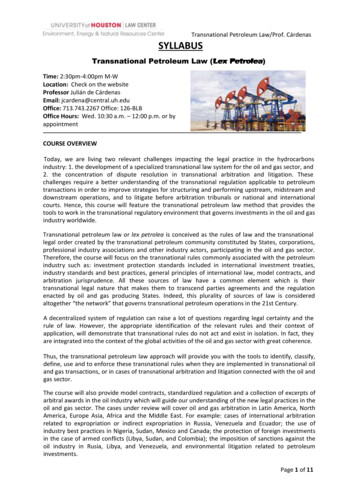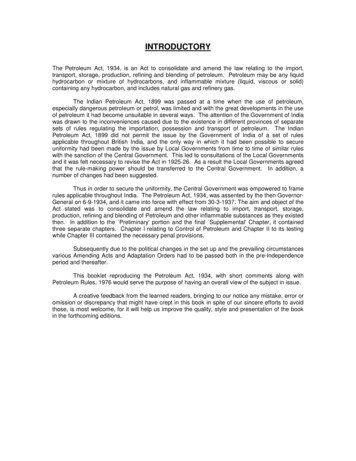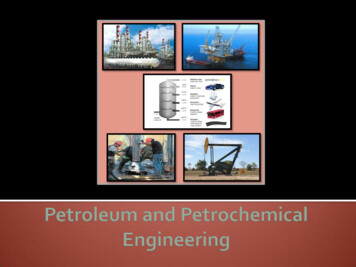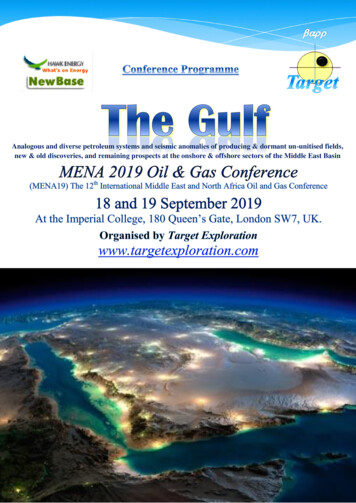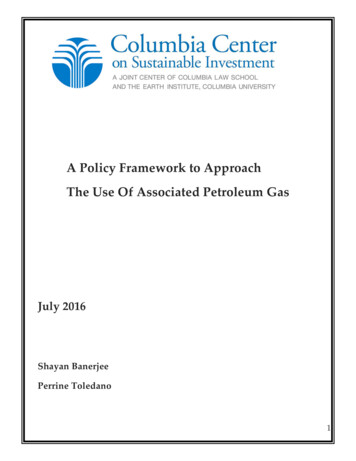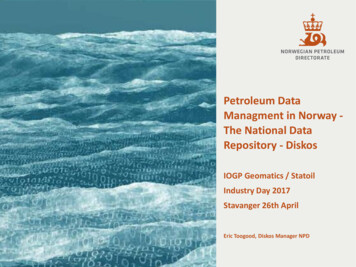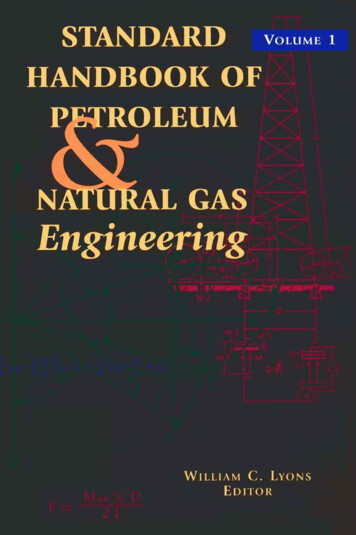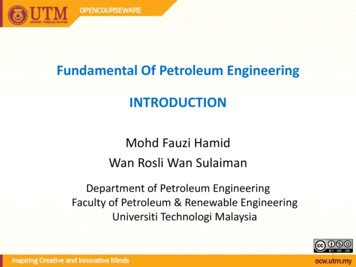
Transcription
Fundamental Of Petroleum EngineeringINTRODUCTIONMohd Fauzi HamidWan Rosli Wan SulaimanDepartment of Petroleum EngineeringFaculty of Petroleum & Renewable EngineeringUniversiti Technologi Malaysia1
COURSE CONTENTS What is Petroleum Engineering?What Does Petroleum Mean?Generation of PetroleumChemical Composition of PetroleumPetroleum ProductsFractional DistillationThe First Oil WellsHistory of Oil in MalaysiaProduction Sharing Contract
What is Petroleum Engineering? an engineering discipline concerned with the activitiesrelated to the production of hydrocarbons, which canbe either crude oil or natural gas. considered as upstream sector of the oil and gasindustry, which are the activities of finding andproducing oil and gas.
What is Petroleum Engineer? A petroleum engineer is involved in nearly all stages ofoil and gas field evaluation, development andproduction. The goal of a petroleum engineer is tomaximise hydrocarbon recovery at a minimum costwhile maintaining a strong emphasis on reducing allassociated environmental problems. Petroleum engineers are divided into several groups: Petroleum geologists find hydrocarbons by analysingsubsurface structures with geological and geophysicalmethods.
What is Petroleum Engineer? Reservoir engineers work to optimize production of oiland gas via proper well placement, production levels,and enhanced oil recovery techniques. Drilling engineers manage the technical aspects ofdrilling exploratory, production and injection wells. Italso include mud engineer who manage the quality ofdrilling fluid. Production engineers, including subsurface engineers,manage the interface between the reservoir and thewell, including perforations, sand control, downhole flowcontrol, and downhole monitoring equipment; evaluateartificial lift methods; and also select surface equipmentthat separates the produced fluids (oil, gas, and water).
Society of Petroleum Engineer The largest professional society for petroleumengineers and publishes much information concerningthe industry. In UTM, SPE UTM Student Chapter – the mostoutstanding SPE Student Chapter in this region. In 2011, SPE-UTM Student Chapter met the goldstandard (top 26 out of more than 200 StudentChapter).
Where Does Petroleum Engineers Work? Employer: GovernmentOil Company.Service Company.Supporting Company.AcademicOthersLocation: OfficeOnland Oil RigOffshore Oil RigOffshore Production Platform
What Does Petroleum Mean? Petroleum literally means ‘rock oil’. The word comesfrom the Greek word ‘petra’ (meaning ‘rock’) and theLatin word ‘oleum’ (meaning ‘oil’). The word petrol is a shortened version of ‘petroleum’.Petroleum products are all the substances made frompetroleum.
Crude Oil The oil we find underground is called crude oil.Crude oil is made of a mixture of different chemicalscalled hydrocarbons. These were produced when tinyplants and animals decayed under layers of sand andmud.Crude oil doesn't always look the same – it depends whereit comes from. Sometimes it is almost colourless, or it can be thick andblack. But crude oil usually looks like thin, brown treacle. When it comes out of a well (especially an undersea well),the crude oil is often mixed with gases, water and sand.
Crude Oil - Wikipedia Petroleum or crude oil is a naturally occurring, toxic,flammable liquid consisting of a complex mixture ofhydrocarbons of various molecular weights, and otherorganic compounds, that are found in geologicformations beneath the Earth's surface. Petroleum isrecovered mostly through oil drilling. It is refined andseparated, most easily by boiling point, into a largenumber of consumer products, from gasoline andkerosene to asphalt and chemical reagents used tomake plastics and pharmaceuticals.
What Made Oil? Tiny animals and plants that live in thesea are called plankton. The plankton that lived in hundreds ofmillions years ago made our crude oil. When they died they sank to the bottomand slowly got buried by sand and mud. Over millions of years, the dead animalsand plants got buried deeper and deeper. The heat and pressure gradually turnedthe mud into rock and the dead animalsand plants into oil and gas.
Hydrocarbon Crude oil is a mixture ofhydrocarbons. They are often chains of carbonatoms with hydrogens attached. The longer chains have higherboiling points, so they can beseparated by distillation. The simplest groups are the alkanesand alkenes. They all end with 'ane'and 'ene' respectively. The first bit of their name dependson the number of carbon atoms.meth 1 carbon, eth 2, prop 3, but 4, pent 5, hex 6.
Generation of Petroleum Petroleum generation takes place in source rocks,which may be defined as organic rich, fine grainedsediments deposited under low energy, reducingconditions. Most commonly, petroleum source rocks containing aminimum of 0.3% to 0.5% by weight of organic matter. Preservation of the organic matter is the key to thedevelopment of potential source rocks. The environment of source rock deposition is thereforecharacterised by a relatively deep, unagitated (lowenergy) body of water with an oxygen starved bottombut abundant life at the surface.
The non-hydrocarbon organic matter (kerogen) is themajor source of oil and gas deposits. The generation of hydrocarbons from the source materialdepends primarily on the temperature to which the organicmaterial is subjected. Hydrocarbon generation appears tobe negligible at temperatures less than 150oF (65oC) in thesubsurface and reaches a maximum within the range of225o to 350oF (107o and 176oC), the “hydrocarbon window”.Increasing temperatures convert the heavy hydrocarbonsinto lighter ones and ultimately to gas. However, attemperatures above 500oF (260oC), the organic material iscarbonized and destroyed as a source material.Consequently, if source beds become too deeply buried nohydrocarbons will be produced. (Wikipedia)
Conversion of Kerogen to Oil & Gas Anaerobic bacteria convert lipids (fat, oil and waxes)into a waxy substance called kerogen. During burial of sediments, the increase in temperatureresults in a progressive change in the composition ofkerogen. Three successive stages are distinguished and referredas diagenesis, catagenesis and metagenesis. The main trend is a continuous increase in the carboncontent of kerogen.
Diagenesis Diagenesis of kerogen is characterised by an importantdecrease of oxygen and a corresponding increase ofcarbon content with increasing depth. CO2, H2O and some heavy N, S, O compounds arereleased. Source rocks are considered as immature at this stage.
Catagenesis A significant decrease in hydrogen content and in theH/C ratio takes place due to the generation and releaseof hydrocarbons. This is the main zone of oil generation and thebeginning of the cracking phase which produces wetgas with a rapidly increasing proportion of methane.
Metagenesis Begins at temperature exceeding 175oC. The stacks of aromatic layers, previously distributed atrandom in kerogen, now gather to form larger clusters. At this stage, only dry gas is generated.During this stage, a rearrangement of the aromatic sheetsoccurs.The color of kerogen changes as it maturesColourMaturity LevelDominant HCYellowImmatureBiogenic methaneOrangeMatureOilBrownMatureWet gasBlackMetamorphosedDry gas
General scheme ofkerogen evolutionpresented on VanKrevelen’sdiagram.
Chemical Composition of Petroleum Substances present in petroleum fall into four majorgroups: ParaffinsNaphthenesAromaticsNon-hydrocarbonThe relative proportions of these compoundsdetermine the physical properties (density, viscosity,pour point, etc) of petroleum.
Paraffins These are also known asaliphatic hydrocarbons. They include the alkanes,which are saturated andhave the general formulaCnH2n 2 (methane, ethane,etc) and the alkenes, whichare undersaturated andhave the general formulaCnH2n or CnH2n-n. The carbon atoms are joinedtogether to form chains.
Naphthenes These are referred toalso as cycloparaffinsand are characterised bytheir carbon atomsjoined in such a way asto form a ring. The heavier MW fractionof petroleum oftencontains quite complexnaphtene moleculeswith two or more ringjoined together.
Aromatics The basic building blockof these hydrocarbons isthe benzene ring. The aromatics structureoccurs especially in thehigh molecular weightfraction of petroleum.
Non-hydrocarbon Compounds in this groupcontain nitrogen, sulphurand oxygen (NSO’s). Free nitrogen gas may begenerated during theformation of petroleum. Sulphur organic compoundsare often foul smelling. Thebest known is H2S. Oxygen compounds includealcohols, ethers and organicacids.
Fractional Distillation Fractional distillation splits the crude oil into simplermixtures called fractions. The different fractions aretaken out of the still at different levels. This happens in a distillation tower (which we shortento still). The crude oil is heated in a furnace to about 370 C andis pumped into the bottom of a distillation tower. Mostof the hydrocarbons are gaseous, though the very thickones are still a liquid even at this temperature.
The tower is like a giant heatexchanger - it removes heat fromthe gases as they rise up it. Thetemperature falls to 20 C by thetime the vapours reach the top. The vapours condense as theyrise up the tower. The heavierones (with higher boiling points)condense first. The thinner, runnyones get further up the towerbefore they condense. And thegases pass out of the top.
Where do Product come out of a Still? A distillation tower splits crudeoil into separate fractions. Each fraction is a mix ofhydrocarbons. Each fractionhas its own range of boilingpoints and comes off at adifferent level in the tower. In reality, a single tower couldnot cover the full range oftemperatures needed to splitup the heavier fractions.
The table shows the names and uses of the fractions thatcome from the distillation process. It also shows the ranges ofhydrocarbons in each fraction.FractionCarbonsBP CUsesGases1 to 4 40 Fuel in refinery Bottled and sold as LPGNapthas5 to 1025 – 175 Blended into petrols Feedstock for making chemicalsKerosene10 to 16150 – 260 Aviation fuelLight gas oils14 to 50235 – 360 Diesel fuel productionHeavy gas oils 20 to 70330 – 380 Feedstock for catalytic crackerLubricants 60340 – 575 Grease for lubrication Fuel additives Feedstock for catalytic crackerFuel oil 70 490 Fuel oil (power stations and ships)Bitumen 80 580 Road and roof surfaces
The First Oil Well The modern oil industry dates back about 150 years. Known as the Drake Well, after "Colonel" Edwin Drake,the man responsible for the well, it began aninternational search for petroleum, and in many wayseventually changed the way we live.The world’s first oil well was drilled in Titusville,Pennsylvania in 1859. It struck oil at 21 metres belowground and produced 3,000 litres of oil a day.
How Long Will The World’s Oil Last? Oil took millions of years to form and the oil supplies inthe ground won't last for ever. The oil fields already discovered hold over 1 millionmillion barrels of oil (1,000,000,000,000). Although we are using oil quite quickly, the reserves goup every year. This is because more oil is discoveredand new ways are found of extracting oil that couldn'tbe got out before. Even so, our oil won't last for ever. At the moment, theworld uses about 26,000,000,000 barrels every year. Atthis rate, there should be enough oil for at leastanother 40 years.
How Long Will The World’s Oil Last? It is likely that more oil will be discovered in that time.Oil companies are always searching for new oil fieldsand there are still lots more deep sea areas to explore.
Source: Wikipedia
World Proven Oil ReservesSource: Wikipedia
World Proven Oil Reserves (ctd)Source: Wikipedia
World Oil ProducerSource: Wikipedia
World Oil Producer (ctd)Source: Wikipedia
World Oil ConsumersSource: Wikipedia
World Oil Consumers (ctd)Source: Wikipedia
World Oil ExportersSource: Wikipedia
World Oil Exporters (ctd)Source: Wikipedia
World Oil ImportersSource: Wikipedia
World Oil Importers (ctd)Source: Wikipedia
World Proven Natural Gas ReservesSource: Wikipedia
World Proven Natural Gas Reserves (ctd)Source: Wikipedia
World Natural Gas ProducerSource: Wikipedia
World Natural Gas Producer (ctd)Source: Wikipedia
World Natural Gas ExportersSource: Wikipedia
History of Oil in Malaysia First oil discovered in Sarawak Malaysia in the year1910. ‘Oilwell Miri No. 1’ is drilled resulting from observationof oil seepages around the area. Located on Canada Hill, Miri. In that time, she had produced 563,484 barrels andwas still producing 10 barrles per day. The first oil refinery in Malaysia is built at Lutong in1917.Start production in December 1910, and closed in1941.
Sarawak: Offshore Oilfields After the discovery of Miri oilfield, further search for oilonshore is carried out for 50 year without any success. Then effort is directed to offshore exploration resultingin the discovery of the Baram oilfield situated 14 kmoffshore. This is followed by the discovery of the West Lutongoilfield and 8 others in deeper water -– Baronia, Bakau,Betty, Bokor, Tukau, Fairley Baram, J4 dan Temana.
Sabah: Offshore Oilfields The search for oil in Sabah started in 1958. An oil terminal is built in Labuan for exporting oiloverseas.The first oilfield discovered is the Erb West in 1971,followed by the Semarang oilfield, South Furious, St.Joseph, Erb South dan Barton.
Semenanjung Malaysia: Offshore Oilfields Offshore Terengganu, Esso discovered oil in 1973. Gasis discovered soon after. Tapis, Pulai dan Bekok are amongst the earlier oilfielddiscovered.
Malaysia Oil & Gas Analysis (As of Jan. 1, 2005) Malaysia is important to world energy markets becauseof its 75 trillion cubic feet of natural gas reserves andits net oil exports of over 300,000 barrels per day. Malaysia contains proven oil reserves of 3.0 billionbarrels, down from 4.3 billion barrels in 1996. Despite this trend toward declining oil reserves,Malaysia 's crude oil production has risen in the lasttwo years as a result of new offshore development. In 2002, crude oil production averaged 699,000 bbl/d.That figure rose to an average of 750,000 bbl/d for2004.
Malaysia 's oil demand has been growing at a muchslower rate due to conservation of natural gas. As a result of the long-term trend toward declining oilreserves, Petronas, the state oil and gas company, hasembarked on an international exploration andproduction strategy. Overseas operations now make up nearly one-third ofPetronas revenue. Malaysia exports the majority of its oil to markets inJapan, Thailand, South Korea, and Singapore.
More than half of the country's oil production comesfrom the Tapis field. Esso Production Malaysia Inc. (EPMI), an affiliate ofExxonMobil Corporation, is the largest crude oilproducer in Peninsular Malaysia, accounting for nearlyhalf of Malaysia 's crude oil production.
Source: http://www.eia.gov
Malaysia contains 75 trillion cubic feet (Tcf) of provennatural gas reserves. Natural gas production has been rising steadily inrecent years, reaching 1.7 Tcf in 2002. Natural gas consumption in 2002 was estimated at 1.0Tcf, with LNG exports of around 0.7 Tcf (mostly toJapan, South Korea and Taiwan). Malaysia accounted for approximately 14% of totalworld LNG exports in 2003. In addition to LNG, Malaysia exports 150 million cubicfeet per day (Mmcf/d) to Singapore via pipeline.
Surprisingly, Malaysia also is an importer of gas fromIndonesia . Petronas signed an agreement in April 2001with Indonesia state oil and gas company Pertamina forthe import of gas from Conoco's West Natuna offshorefield in Indonesian waters.
Source: http://www.eia.gov58
Refining and Downstream Malaysia has six refineries, with a total processingcapacity of almost 600,000 bbl/d. Kertih Refinery (Petronas), Terengganu, 40,000 bbl/d. Port Dickson Refinery (Royal Dutch Shell), 156,000 bbl/d.Melaka I Refinery (Petronas) Melaka, 100,000 bbl/d.Melaka II Refinery (Petronas/Conoco Philips) Melaka,170,000 bbl/d.Esso Port Dickson Refinery (ExxonMobil), 88,000 bbl/d.Lutong Refinery (Royal Dutch Shell) Sarawak,45,000 bbl/dSource: wikipedia.org/
Petronas Petronas, short for Petroliam Nasional Berhad,[1] is aMalaysian-owned oil and gas company that wasfounded on August 17, 1974. Wholly owned by the Government, the corporation isvested with the entire oil and gas resources in Malaysiaand is entrusted with the responsibility of developingand adding value to these resources. Since its incorporation, Petronas has grown to be anintegrated international oil and gas company withbusiness interests in 31 countries.More information: http://en.wikipedia.org/wiki/Petronas
Production Sharing Contract Production Sharing Contracts (PSC) or Productionsharing agreements (PSAs) are a common type ofcontract signed between a government and a resourceextraction company (or group of companies)concerning how much of the resource (usually oil)extracted from the country each will receive.More information: http://en.wikipedia.org/wiki/Petronas
In PSAs the country's government awards the executionof exploration and production activities to an oilcompany. The oil company bears the mineral andfinancial risk of the initiative and explores, develops andultimately produces the field as required. Whensuccessful, the company is permitted to use the moneyfrom produced oil to recover capital and operationalexpenditures, known as "cost oil". The remaining moneyis known as "profit oil", and is split between thegovernment and the company, typically at a rate of about80% for the government, 20% for the company. In somePSAs, changes in international oil prices or productionrate can affect the company's share of production.Source: wikipedia.org/
What Does Petroleum Mean? Petroleum literally means 'rock oil'. The word comes from the Greek word 'petra' (meaning ' rock ') and the Latin word 'oleum' (meaning ' oil '). The word petrol is a shortened version of 'petroleum'. Petroleum products are all the substances made from petroleum.
